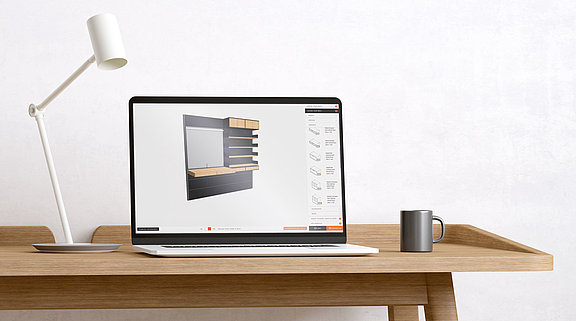7 Most frequently asked questions about the configurator platform
Author: Elisabeth Sonnleitner
Welcome to today's blog article! We are excited to present you with the answers to the most frequently asked questions about the Combeenation Configurator Platform. In this article, we are particularly focusing on agencies, companies and individuals who are interested in independently creating a configurator on the Combeenation platform.
1. What options do I have with the platform?
With the Combeenation platform, companies can quickly and easily create an unlimited number of product configurators. No matter if in 2D or 3D. In addition, it is also possible to display products in 3D and augmented reality with just one click and to integrate them on your own website.
You can implement both simple and complex configurators with the platform. For example, a simple configurator could present sunglasses that are available in two different colors. A complex configurator could again be a garden shed with many different configuration options.
With the Combeenation platform, almost unlimited design options are available. You can make cosmetic changes such as color and surface adjustments, as well as functional adjustments that allow you to show and hide elements. Dimensionally accurate sizing can also be implemented.
In addition to the numerous configuration and personalization options, various applications arise. One example is the direct creation of a quotation or the export of 3D models and technical drawings from the configuration. Even simple adjustments like exchanging a background can be implemented effortlessly. As you can see, there are countless possibilities and we could continue the list indefinitely. Click through our case studies to get an insight into already implemented configurator projects.
To give a little more insight, we would like to mention a few points, which include the development environment, for example:
- Interactive viewer for 2D & 3D
- Asset area with version management
- Productive and test environment for the configurators
- Version history with rollback function
- Multiple standard checkout options
- Dashboard with key performance KPIs
- User administration & rights management
- Automatic, scheduled or push-based data import in dedicated workflow area
Again and again we get the question whether the Combeenation platform is a long-term solution. Yes, it is. Combeenation configurators are designed from the ground up to be maintainable and easily expandable over the long term. In addition, we continuously develop the platform further, from which all our customers benefit.

Configurator checklist
Avoid stumbling blocks.

2. What knowledge do I need to use the platform?
At present, it is not yet possible without any technical knowledge at all. Web or JavaScript developers are able to build configurators with the platform. After free registration you have full access to the development environment. Our experience shows that it is possible to create simple configurators within a short time.
In order to specifically map and create specific configuration logics, we have developed a programming language called "Hive", whose syntax is strongly based on JavaScript. By using JavaScript, Combeenation configurators can be extended with a variety of customer-specific functions.
To facilitate the use of the platform, we provide a documentation with detailed explanations. In addition, there is a forum and numerous tutorial videos. Furthermore, we are happy to offer initial onboarding at any time and are available to answer any questions you may have.
3. What does the use of the platform cost?
Registration and use of the platform is free of charge for the first 30 days. After registering, you have immediate access to the entire development environment to experiment on the platform and try out different options. The monthly costs for using the platform are only incurred if you decide to continue using it after the 30-day test phase. In general, we would like to emphasize: Before any costs are incurred, we always make this clearly visible. You can find more information about the pricing model here.

4. How are data protection and security of product data ensured?
Combeenation uses the Microsoft Azure cloud platform. The configurator data is stored in European data centers. Communication with the end device is always encrypted via TLS. The product master data and the product logic, which are your intellectual property, are never transferred to the end device, but are processed in the cloud, and only the display results are sent to the end device in real time.
5. Interfaces & embedding in website
The integration of Combeenation configurators is uncomplicated. The configurator is integrated via iFrame - wherever you want and as often as you want. Either directly on the start page, product page or in a dealer portal or customer portal.
Can I also interface with systems? Yes, the platform can connect to all systems that provide an API. It is important to define how the systems communicate with each other and which data should be exchanged.
Let's look at a use case for automated data import: Shopware provides a URL with authentication key. This can be used to retrieve all data such as prices, availabilities and product data in real time or at a specified interval. The data can be easily connected using our platform feature "Workflows" and used in the configurator. This ensures that the data only needs to be maintained at one point and is always up-to-date in the configurator. In addition to importing data, it is of course also important to be able to further process the completed configuration. The goal of the checkout process is to transfer specific information or data from the configuration to the shopping cart, the ERP system, to a third-party application, or even to the customer.
For the most common store systems there are plugins from us, which can be used. In addition, REST or FTP calls are possible to ensure the connection to all systems.

6. How long do I need to create a configurator?
The time you need to create a configurator depends on several factors, including the complexity of the configurator, the functionality, the desired features and the experience of the development team. Often it is the features that are not directly visible that take up a lot of time, such as database connections, detailed dimensions or the creation of PDF data. A very simple product configurator can be implemented in just a few hours. For somewhat more extensive configurators, you need in the range of 60 to 120 hours. And depending on the product complexity like a system furniture also up to 300 h. If you need detailed information on this topic, we would like to refer you to another blog article in which we present various case studies with the required hours in detail [link blog article]. In any case, with the Combeenation platform you are significantly faster, up to 80%, than in the self-build - where you have to program everything yourself.
7. What do I need to know about the 3D models?
How do I get 3D models for my configurator?
There are several ways to have a 3D model created. Should you have the appropriate expertise, it is also possible to create the 3D model yourself. If this is not the case, we recommend using an agency that specializes in 3D modeling. At Combeenation, we also offer a 3D service that makes it easy for you to have your desired 3D models created at a fixed price.
I already have 3D models
However, if you already have 3D models, we will be happy to sift through the existing material. The central questions here are: In which format is the data available and is it optimized for display on the web?
How much does a 3D model cost?
You may certainly ask: What are the costs associated with a 3D model? The price of a 3D model is influenced by various factors:
- The level of detail and complexity of the product naturally play a decisive role. For example, is it a simple round soccer ball or a highly detailed kitchen appliance.
- The modularity, that is, how many parts can be configured.
- The underlying source data is also important. This includes images, technical documentation or, in the best case, CAD data.
Since we are asked this question again and again, we have created an online page. In it you can find exemplary 3D models, which are deposited with a guideline price. So you get an approximate feel for it.
What do I have to consider for 3D data for configurators?
When providing 3D data for configurators, one essential criterion must be observed: The 3D models should be suitable for use on the web. This requires both a small file size and optimization for low-poly meshes to ensure smooth display on the Internet. It is important that the models can be displayed smoothly on all devices and yet all important product details remain clearly visible. It is advisable to avoid high-resolution models, such as those often used in architecture or advertising, and instead use 3D models suitable for the web.
Which source data is suitable for 3D data?
There are different source data for 3D data. Generally, the more imprecise and unstructured the raw data, the more complex and expensive it will be to create. The most common source data include:
- CAD data
- Photos
- Polygonal data
- Drawings in vector or raster format
- Physically provided products
For more detailed information on the individual source data, read our blog article: "Creating 3D models: Which data is suitable"?
Do you still have unanswered questions? We would be happy to take the time for a personal discussion with you to answer any unanswered questions. We look forward to the personal exchange.

Configurator checklist
Avoid stumbling blocks.

